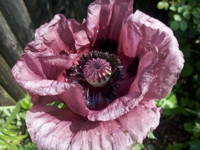
- Seeds of annuals that require 10-12 weeks of growth before transplanting can be started indoors now.
- Plant cool-season annuals, such as pansies, snapdragons, and calendulas at the end of the month, weather permitting.
- Some seeds can be sown onto an inch or so of melting snow on a calm day. These include poppy, calendula, evening primrose and lupine. Be sure the area beneath the snow is bare ground.
- Using sterile growing mix for starting seeds reduces problems with damping-off fungi. Avoid overwatering, which encourages root rots.
- Once your garden beds thaw, remove old garden debris such as leaves, stalks, and seed heads to reduce the presence of any overwintering diseases and pests.
- Before new shoots emerge, cut back last year’s stalks on perennials and grasses.
- Divide hosta when shoots appear. Clumps can be dug up, split and replanted.
- Prune old, leggy growth from heather (which flowers on new growth in late summer) but prune heath (which sets its flower buds in late spring) just enough to shape it in the early spring.
- Back to top of page

- Visit the greenhouses at Elizabeth Park in West Hartford to view the tulips and other spring-flowering bulbs.
- Sign up for gardening classes or seminars offered by many garden centers or town recreation office or through the UConn Master Gardener Program.
- Sign up for free composting webinars in March and April.
- Back to top of page.
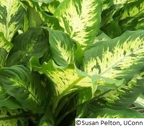
- Provide houseplants with increased humidity; mist often or place plants over a tray of moist pebbles.
- When buying houseplants in winter, be sure to wrap them well for the trip home and, if possible warm up the car. This prevents the foliage from freezing and protects tropicals from drafts.
- Continue to clean leaves of large and smooth leaved houseplants like dracaena, philodendron, ficus, etc.
- Clean clay pots by soaking overnight in a solution of 1-gallon water and 1 cup of vinegar. Scrub to remove deposits. Repeat if necessary.
- Check your stored plants such as fuchsias and geraniums. Usually they need a light watering once a week depending on their storage temperature.
- If you potted bulbs for forcing last fall, check their progress. Soil should be barely moist. If tips have sprouted and have a few inches of growth, bring the pot into a cool, bright room (50 to 60 degrees F). Gradually expose the plant to increasing warmth, indirect sunlight, and increased watering. Feed once a week with half-strength houseplant fertilizer. To help the stems grow straight, turn the pot every day. When buds and foliage are fully developed, bring into full sunlight, and enjoy!
- Cut back geraniums, hibiscus, and other houseplants for repotting next month.
- Begin fertilizing houseplants with a water-soluble fertilizer as they resume active growth.
- If house plants are growing tall and leggy, they probably need supplemental light. Use fluorescent lights to help compensate for short days.
- Keep pinching over-wintering coleus, they tolerate major cutting back and routine pinching to encourage bushy growth. New plants can be propagated with the cuttings.
- Back to top of page
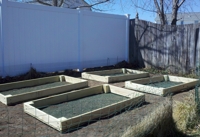
- Send your vegetable garden soil samples to the UConn Soil Nutrient Analysis Laboratory for testing.
- Finish getting your seed and plant orders in by mail or on-line.
- Seeds of vegetables, such as tomatoes, peppers, eggplants, and herbs that require 10-12 weeks of growth before transplanting can be started indoors this month.
- Using sterile growing mix for starting seeds reduces problems with damping-off fungi. Avoid overwatering, which encourages root rots.
- Seeds of cold weather vegetables like spinach, peas, lettuce and broccoli can be direct seeded as soon as soil is workable.
- Raised beds are a great alternative when the available soil is poor and this is a good time to construct them.
- Weed early as the unwanted seedlings slip out more easily in moist early-spring soil.
- Back to top of page
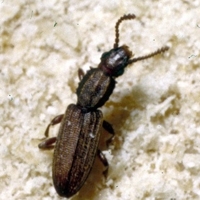
- Clear out open cereal and grain boxes, store in tight-sealed plastic containers, and vacuum the pantry to control pantry pests as part of Spring cleaning.
- Prune or peel off and destroy Eastern tent caterpillar egg masses. Favorite hosts include cherry, crabapple and apple. Look for the shiny, dark brown egg masses about 1" wide wrapped around small twigs.
- Inspect bark of cherry, plum and peach for powdery white prunicola scale infestations and plan horticultural oil applications if needed. A brush is sometimes useful for mechanically rubbing the insects off.
- Check for tan spongy moth egg masses on tree trunks and branches. Scrape or brush off and destroy if possible.
- Be on the lookout for spotted lantern fly egg masses and report them to CAES.
- Back to top of page
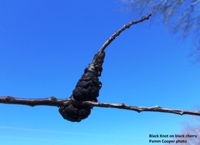
Fruits
- Prune out and destroy dark, swollen black knot galls on twigs of cherry and plum before budbreak. On trees, shrubs, fruiting bushes and vines, prune off and destroy cankered twigs and any branches showing dieback. Prune shortly before budbreak, or wait until just after leaves have expanded.
- Fertilize fruit trees in late March, weather permitting.
- Thin bramble plantings (raspberries, blackberries, etc.) to increase air circulation and reduce stem and leaf disease problems.
- Fertilize blueberries before budbreak.
- Inspect bark of cherry, plum and peach for powdery white prunicola scale infestations and plan horticultural oil applications if needed. A brush is sometimes useful for mechanically rubbing the insects off.
- Prune or peel off and destroy Eastern tent caterpillar egg masses. Favorite hosts include cherry, crabapple and apple. Look for the shiny, dark brown egg masses about 1" wide wrapped around small twigs.
Lawns
- Get your soil tested through the UConn Soil Nutrient Analysis Laboratory before any major planting or fertilizing venture. Soils sent in before April 1 will avoid the spring rush.
- Add limestone, fertilizer or organic materials as recommended and incorporate into planting beds if soils are not too wet, but don’t fertilize the lawn until mid-April.
- As ground becomes workable, de-thatch the lawn if you find an inch or more of thatch; seed any bare spots.
- Compacted soils can be improved by loosening and adding 1 - 3 inches organic matter.
- Turn the compost pile; if it is too moist add dry materials that are high in carbon such as shredded newspaper, straw or shredded leaves.
- For easier lawn maintenance, eliminate the hard to mow spaces such as acute angles in beds and borders. Combine single trees or shrubs into a large planting connected with ground cover. Put the bird bath in a flower bed or surround it with ground cover.
Trees and Shrubs
- Soak mail order bare-root plants for about an hour before planting.
- Carefully remove winter mulches from planting beds as snow melts and temperatures warm but leave it nearby so that tender plants may be recovered if there is a frost.
- Check landscape plants for winter damage and prune if necessary after all freezing temps have passed for the season and new growth begins.
- Horticultural oil applications at dormant rates are usually applied from late March through early May, depending on plants to be treated and weather conditions.
- Check for tan spongy moth egg masses on tree trunks and branches. Scrape or brush off and destroy if possible.
- Check trunk and rough branch areas of white pines for cottony white flecks of pine bark adelgid. Plan horticultural oil treatment if needed.
- Horticultural oil treatments for maple bladder gall mite, pear psylla, and scale on shrubs and trees can be applied; check labels for specifics on appropriate weather conditions.
- Prune off and destroy brown shoot tips killed by Nantucket pine tip moth on Japanese black, mugo, scots, Austrian and other 2- and 3-needled pines. Damaged tips are brown and hollow in the center from the feeding of the caterpillars.
- Remove and destroy infested foliage on arborvitae, boxwood, and juniper to control leafminer. Look for browned foliage that is hollowed out to detect the problem.
- Move woody plants before they begin new spring growth; transplant as soon as the soil is workable.
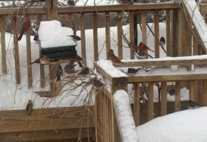
- Keep any birdseed and pet food that is stored in the garage in tightly covered containers to prevent rodents and wildlife from getting into it.
- FrogWatch USA is looking for volunteers to record the number and varieties of frogs around the country.
- Bring in bird feeders once black bears emerge from hibernation.
- Back to top of page
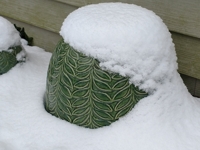
- Start cleaning containers and pots so they are ready for planting.
- Start your lawn mower, check to see if it needs service, and get the blades sharpened.
- Clean and sharpen garden tools. Take an inventory of supplies you will need for the upcoming growing season. Paint handles red or orange to make them more visible on the lawn.
- Save plastic milk jugs or 2-liter containers to use as individual hot caps or cloches. They will fit nicely over small garden plants, creating a free miniature greenhouse.
- Back to top of page
Despite good cultural practices, pests and diseases at times may appear. Chemical control should be used only after all other methods have failed.
For pesticide information please call UConn Home and Garden Education Center weekdays, in Connecticut call toll free 877-486-6271. Out of state call 860-486-6271
Revised by the UConn Home and Garden Education Center 2023
Issued in furtherance of Cooperative Extension work, Acts of May 8 and June 30, 1914, in cooperation with the U.S. Department of Agriculture, the Dean of the College, Cooperative Extension System, University of Connecticut, Storrs. The Connecticut Cooperative Extension System is an equal opportunity employer and program provider. To file a complaint of discrimination, write USDA, Director, Office of Civil Rights, Room 326-W, Whitten Building, Stop Code 9410, 1400 Independence Avenue, SW, Washington, DC 20250-9410 or call (202) 720-5964.